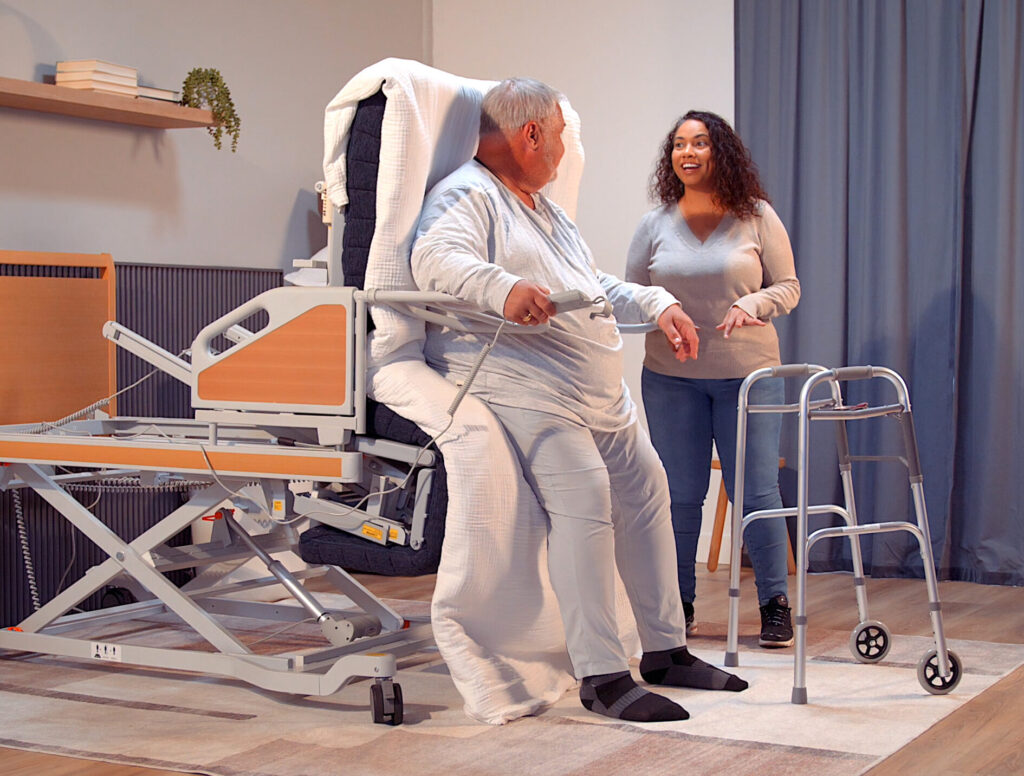
It’s National Physical Therapy Month! Take Steps to Better Mobility
Each October, we observe National Physical Therapy Month to highlight the numerous benefits of physical therapy for consumers, and the vital role it plays in promoting health & wellness. The American Physical Therapy Association (APTA) started celebrating Physical Therapy Week in the early 1980s, and the first National Physical Therapy Month was celebrated in October 1992. This month serves as an opportunity to recognize the contributions of physical therapists and physical therapist assistants in enhancing patients’ quality of life. Through personalized treatment plans, these professionals address various conditions, from sports injuries to chronic pain, helping individuals regain mobility and improve their functional abilities.
The theme for National Physical Therapy Month often emphasizes awareness of the benefits of physical therapy, advocating for its role in prevention, rehabilitation, and overall health management. Educational events and community outreach programs raise awareness about how physical therapy can aid in recovery and enhance athletic performance. By focusing on injury prevention and promoting active lifestyles, this practice encourages individuals to take charge of their health. Ultimately, National Physical Therapy Month fosters appreciation for this essential field, inspiring more people to seek the benefits of physical therapy in their lives.
This article provides readers with impactful information about physical therapy, the illnesses or injuries that it can be an asset to, and the overall benefits that one would reap long term. Furthermore, it helps note the differences between physical therapy and occupational therapy and explains in detail the assistive medical devices that can ultimately help you through your healing process.
5 Facts About Physical Therapy That You May Not Know
- Ancient Roots of Physical Therapy: In 435 BC, Hippocrates started promoting the use of massage, hydrotherapy, and manual therapy techniques for patient care. This is thought to be the earliest foundation of what we now recognize as physical therapy.
- Physical Therapy Can Treat Pain in Removed Limbs: Physical therapy can effectively address “phantom” limb pain, a frequent occurrence following an amputation. It aids in retraining the brain to interpret sensory information in new ways, which can alleviate pain and enhance overall function.
- Physical Therapy During WW1: During World War I, physical therapists were known as “reconstruction aides” serving as civilian employees of the U.S. Army Medical Department. Their primary responsibility was to create rehabilitation programs for injured soldiers to help restore their mobility and range of motion.
- Physical Therapy in Water: Aquatic physical therapy is a type of physical therapy conducted in a pool or other water settings. It is commonly combined with land-based therapies to treat, manage, and aid recovery for various conditions.
- Physical Therapy Should Not Cause Pain: Although some of a physical therapist’s techniques may cause initial discomfort, their aim is to help patients reach a pain-free state and encourage healing without inflicting unnecessary irritation. Severe pain should never be experienced, and it’s essential to be able to distinguish the difference between that and soreness.
Types of Physical Therapy
To ensure distinct, patient needs are met, there are various types of physical therapy, and the field is constantly evolving with the introduction of new specialties and techniques.
Here are a few of the most common types:
- Cardiovascular and Pulmonary physical therapy is a specialized form of treatment aimed at enhancing the function of the lungs and heart. It is beneficial for individuals dealing with various conditions such as asthma, high blood pressure, chronic bronchitis, heart failure, etc.
- Geriatric Physical Therapy stands apart from other forms of physical therapy as it emphasizes enhancing strength and endurance in older adults. This approach aims to maintain an active lifestyle and prevent the decline in the body’s physical function due to a lack of activity, prolonged bed rest, or an extremely sedentary lifestyle. A similar type that would be more for the younger or middle-aged population is Orthopedic Physical Therapy. This practice is aimed at treating and rehabilitating injuries to the musculoskeletal system, such as bones, muscles, joints, tendons, and ligaments.
- Neurologic Physical Therapy helps people recover or improve their movement and function after a nervous system injury or disease, like a stroke, brain injury, or multiple sclerosis. The focus is on exercises and techniques that enhance mobility, balance, and daily activities.
- Pediatric Physical Therapy is a specialized field focused on helping children enhance their motor skills, coordination, balance, strength, and endurance.
- Oncology Physical Therapy also known as oncology rehabilitation, is a specialized type of physical therapy that helps people with and beyond cancer recover from physical impairments caused by cancer treatments.
If you experience discomfort or pain from any of the health issues above, ask your doctor if seeking a physical therapist is right for you!
Benefits of Physical Therapy
Now that we have introduced the numerous types of physical therapy and what they treat, let’s dive a little deeper and explore the benefits of going!
- Preventing Decline with Early Mobility: Physical therapists play a crucial role in preventing mobility decline by instructing patients in safe and effective exercises to enhance their range of motion as well as muscle strength. Early mobilization is vital as it can reduce the risk of complications such as blood clots, pneumonia, and pressure injuries such as bed sores, while also promoting better functional mobility.
- Safe Discharge Planning: Following discharge precautions, when a patient has been hospitalized, is of the utmost importance. A physical therapist takes note of various concerns, such as the patient’s functional ability, safety to discharge to home, what is the required level of assistance needed, what type of medical equipment would helpful, and necessary follow-up rehabilitation services. Inadequate discharge planning and a lack of essential services can affect multiple areas. If these steps are not carefully completed, the patient may struggle to achieve optimal health and functional status, hospital costs may rise due to prolonged stays and readmissions, which can ultimately cause a domino effect exposing the patient to health care-associated infections.
- Avoid Surgery: While modern medicine has achieved remarkable technological advancements that enhance surgical procedures, treatment strategies aimed at preventing or delaying surgery have also progressed significantly. A key benefit of physical therapy before surgery is that it carries no risk.
- Drug-Free Pain Relief: Physical therapy adopts a more holistic approach to healing, emphasizing the treatment of underlying issues that cause pain and discomfort instead of merely alleviating symptoms with medication. Many people would prefer a natural healing process than being dependent upon over-the-counter drugs that can have significant side effects.
- Improve Mental Health: The influence of physical therapy on mental health extends beyond just physical health. Certain exercises stimulate the release of serotonin and beta-endorphins, which are linked to an improved mood and overall well-being. These hormones play a significant role in shaping an individual’s mood, motivation, and physical condition. As patients improve their physical abilities, they may also experience a boost in self-esteem and confidence. Many physical therapy sessions are held in groups, offering chances for social interaction and support, which allow patients to have some normalcy back in their lives.
If you would like more information on how you can improve your mental health, check out our last blog Mental Health Tips: Simple Ways to Boost Your Well-Being (keywaymedical.com).
Physical Therapy vs Occupational Therapy
Many people mix up the two and believe that they are interchangeable. Although they differ from each other in some ways, they do have the same end goal. Physical therapy and occupational therapy are both essential rehabilitation services, but they serve different purposes. Physical Therapy focuses on improving a patient’s physical function, mobility, and strength. It often addresses issues related to injuries, surgeries, or chronic pain, aiming to restore movement and enhance overall physical capabilities. Physical therapy treatments involve exercises, heat and cold therapy, massage, and muscle manipulation.
In contrast, occupational therapy emphasizes enabling individuals to perform daily activities and achieve independence despite physical or cognitive challenges. This kind of therapy can assist with a wide range of medical conditions, including developmental disorders like autism, traumatic brain injuries, side effects from cancer treatment, age-related issues such as reduced coordination, mental health disorders like schizophrenia, carpal tunnel syndrome, and many others. Occupational therapists work on skills necessary for completing day to day tasks, such as dressing, cooking, or working, often adapting environments to facilitate these tasks. Occupational therapy treatments consist of exercises, massage, stress management, activities of daily living training, perceptual training, and neurological development. An occupational therapist may suggest specialized equipment for clients, including mobility aids and eating utensils or communication devices to achieve independency.
Despite their differences, physical therapists and occupational therapists frequently collaborate to create treatment plans for their patients, allowing them to mutually benefit from each other’s expertise. They each focus on both the mind and body, viewing the patient as a whole. Together, physical therapy and occupational therapy complement each other in holistic patient care.


How Medical Devices Advocate for Physical Therapy
Mobility aids and medical devices, such as walkers, beds, and canes, play a crucial role in your physical therapy journey. These devices provide stability and support, allowing individuals to move safely and effectively. With the appropriate mobility aid, patients can perform daily activities, engage in physical therapy exercises, and gradually build strength and endurance. Furthermore, advancements in AI and technology enable physical therapists to gather specific data through mobile apps or motion capture tools, allowing them to tailor care plans to individual needs.
Here are some suggested products that are beneficial to patients and their therapists:
- ReNuCare® Standing Bed: Designed for seniors and those recovering from surgery or injury, these beds assist in safe transitions from lying down to standing. Featuring adjustable heights and support bars, they enhance stability and reduce the risk of further injury. The adjustable positioning can alleviate pressure sores, boost circulation, increase patient comfort, and ease the physical strain on caregivers, making them an essential tool in rehabilitation.
- ReNuCare® AI Mattress: This AI-powered mattress features a pressure relief system that automatically adjusts its firmness to adapt to your body’s specific needs while you sleep. By alleviating back pain and eliminating pressure points, it supports the healing process, complementing physical therapy. The accompanying app tracks your sleep patterns, providing valuable insights for your physical therapist to refine your care plan.
- ReNuCare® IERO Cruise: This compact and easy-to-maneuver mobility scooter is designed for individuals who require assistance while maintaining an active lifestyle. With its lightweight frame and ergonomic design, the IERO Cruise allows users to navigate various environments safely, fostering independence. By enhancing mobility, it encourages patients to participate in physical therapy exercises outside of clinical settings, promoting engagement and consistent practice.
- ReNuCare® Power Ride: Engineered for comfort and ease of use, this electric wheelchair provides individuals with enhanced mobility and support. Its adjustable seating and intuitive controls allow for a personalized fit, making it easier for users to engage in physical therapy sessions. By enabling patients to move more freely, the Power Ride encourages participation in rehabilitation activities, reinforcing the principles of strength and endurance training essential for recovery.
Conclusion: A Holistic Approach to Healing
National Physical Therapy Month highlights the benefits of physical therapy, from personalized treatment plans for various conditions to enhancing patients’ quality of life. This blog outlines interesting facts and information about physical therapy, such as its historical roots, its effectiveness in treating phantom limb pain, and its various specialized types, including pediatric and oncology therapy. It emphasizes the numerous benefits, like preventing mobility decline, avoiding surgery, and improving mental health through holistic approaches. Overall, National Physical Therapy Month serves as an opportunity to recognize this vital portion of the healthcare industry.
Please note that this article is for informational purposes only. For personalized health advice, we recommend consulting a health professional. If you desire to invest in cutting-edge assistive devices that uphold the highest standards of safety, quality, and sustainability, the ReNuCare®products may be right for you! Contact us today for more information or to schedule a demo—we’re here to help!
References
Harvard Health. (2024). Physical Therapy: Myths vs. Reality. Retrieved from: https://www.health.harvard.edu/staying-healthy/physical-therapy-myths-vs-reality
University of the Cumberlands. (2023). 7 Ways Technology Is Changing Physical Therapy. Retrieved from: https://www.ucumberlands.edu/blog/technology-is-changing-physical-therapy
National Library of Medicine. (2010). Physical Therapists Make Accurate and Appropriate Discharge Recommendations for Patients Who Are Acutely Ill. Retrieved from: https://pmc.ncbi.nlm.nih.gov/articles/PMC2867215/
National Library of Medicine. (2024). In Brief: Physical Therapy. Retrieved from: https://www.ncbi.nlm.nih.gov/books/NBK561514/
National Library of Medicine. (2007). A History of Manipulative Therapy. Retrieved from: https://pmc.ncbi.nlm.nih.gov/articles/PMC2565620/
Johns Hopkins Magazine. (2016) Post-ICU, Many Patients Experience Symptoms of Depression. Retrieved from: https://hub.jhu.edu/magazine/2016/winter/icu-hospital-depression/
American Physical Therapy Association. (2024). National Physical Therapy Month Is Here. Retrieved from: https://www.apta.org/article/2024/10/01/national-pt-month–2024-is-here


